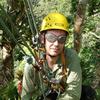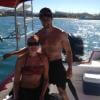Acoustic sensors enable efficient and non-invasive monitoring of a wide range of species, including many that are difficult to monitor in other ways. Although they were initially limited in application scope largely due to cost and hardware constraints, the development of low-cost, open-source models like the Audiomoth in recent years has increased access immensely and opened up new avenues of research. For example, some teams are using them to identify illicit human activities through the detection of associated sounds, like gunshots, vehicles, or chainsaws (e.g. OpenEars).
With this relatively novel dimension of wildlife monitoring rapidly advancing in both marine and terrestrial systems, it is crucial that we identify and share information about the utility and constraints of these sensors to inform efforts. A recent study identified advancements in hardware and machine learning applications, as well as early development of acoustic biodiversity indicators, as factors facilitating progress in the field. In terms of limitations, the authors highlight insufficient reference sound libraries, a lack of open-source audio processing tools, and a need for standardization of survey and analysis protocols. They also stress the importance of collaboration in moving forward, which is precisely what this group will aim to facilitate.
If you're new to acoustic monitoring and want to get up to speed on the basics, check out these beginner's resources and conversations from across the WILDLABS platform:
Three Resources for Beginners:
- Listening to Nature: The Emerging Field of Bioacoustics, Adam Welz
- Ecoacoustics and Biodiversity Monitoring, RSEC Journal
- Monitoring Ecosystems through Sound: The Present and Future of Passive Acoustics, Ella Browning and Rory Gibb
Three Forum Threads for Beginners:
- AudioMoth user guide | Tessa Rhinehart
- Audiomoth and Natterjack Monitoring (UK) | Stuart Newson
- Help with analysing bat recordings from Audiomoth | Carlos Abrahams
Three Tutorials for Beginners:
- "How do I perform automated recordings of bird assemblages?" | Carlos Abrahams, Tech Tutors
- "How do I scale up acoustic surveys with Audiomoths and automated processing?" | Tessa Rhinehart, Tech Tutors
- Acoustic Monitoring | David Watson, Ruby Lee, Andy Hill, and Dimitri Ponirakis, Virtual Meetups
Want to know more about acoustic monitoring and learn from experts in the WILDLABS community? Jump into the discussion in our Acoustic Monitoring group!
Header image: Carly Batist
Texas A&M University
- 1 Resources
- 3 Discussions
- 2 Groups
- @RHugtenburg
- | He/They
Student at Aberystwyth University. Bug Fanatic🪲. Worked at Octophin Digital for my industrial year placement 🐙.
- 0 Resources
- 0 Discussions
- 20 Groups
- @CynthiaGw
- | Her/she
Hi, Cynthia Gichimu here. I'm a conservationist, and a champion for youths. I believe in environmental sustainability for posterity. I volunteer as a Project Officer with the Friends of Kinangop Plateau, a community-based local action group committed to biodiversity conservation.
- 1 Resources
- 3 Discussions
- 6 Groups
Ramiro is an ecologist whose research interests are in the fields of applied animal ecology and conservation biology. He addresses critical research questions by integrating a combination of field data collection, GIS, remote sensing, and advanced modelling techniques.
- 0 Resources
- 0 Discussions
- 7 Groups
- @caseyjoscience
- | she/her
Recent grad with extensive experience in marine mammal AI and marine mammal bioacoustics!
- 0 Resources
- 0 Discussions
- 3 Groups
- 0 Resources
- 0 Discussions
- 2 Groups
- 0 Resources
- 0 Discussions
- 8 Groups
- @Sophy
- | She/Her
- 0 Resources
- 0 Discussions
- 2 Groups
- @rmjtjp
- | She/They
- 0 Resources
- 0 Discussions
- 7 Groups
Drone Operator and Tech Developer


- 0 Resources
- 33 Discussions
- 9 Groups
Conservationist currently working as UAS Remote Pilot & with ecoacoustics
- 0 Resources
- 5 Discussions
- 4 Groups
Ornithologist working on passive acoustic monitoring equipment R&D in China
- 0 Resources
- 0 Discussions
- 1 Groups
Careers
Island Conservation's Innovation Team is dedicated to developing innovative, data-driven tools to increase the scale, scope, and pace of island restorations around the world. As the Conservation Innovation Manager, you...
27 September 2023
If only there was a place where these users, manufacturers, and supporters of conservation technology could connect with one another. There is. It is called WILDLABS.
22 September 2023
The new white paper from Rainforest Connection (RFCx) explores the power of ecoacoustics and AI to monitor biodiversity and track progress towards GBF targets using case studies from around the world.
20 September 2023
Article
Five #tech4wildlife people, projects and updates that caught our attention this month. An AI supported bear early warning system, a project that's connecting indigenous communities with high speed internet, exploring...
12 September 2023
It's relatively easy to collect vast amounts of audio data - it's not so easy to analyse it and get consistent results. The Wilder Sensing platform enables users to upload vast quantities of audio which is then analysed...
1 September 2023
News about a population survey of California Spotted Owls using 1,600 autonomous recording units in the Sierra Nevada region. Machine learning made analyzing this acoustic data possible at this large scale for the first...
29 August 2023
The Smithsonian Institution seeks a field- and data-oriented biologist to support marine animal telemetry research and to assist with activities of the Atlantic Cooperative Telemetry (ACT) Network.
24 August 2023
Apply to work on a wonderful team translating acoustic monitoring data into conservation & ecological insights!
11 August 2023
This article discusses Cornell's bioacoustics work with AI tools to recognize both elephant "voices" as well as gunshots. The elephant rumbles analyzed in this work are almost imperceptible to the human ear, but can be...
9 August 2023
Please join us in celebrating this year’s top #Tech4Wildlife Photo Challenge Honorees as chosen by our panel of leading conservation organization judges, and enjoy the story contained within these entries about how our...
4 August 2023
Exciting opportunity for an experienced biodiversity monitoring expert in ZSL's conservation department
18 July 2023
Global methane data and new functionaity on the Carbon Mapper Data Portal
12 July 2023
June 2025
July 2025
September 2025
event
October 2025
November 2025
event
July 2021
December 2020
June 2020
61 Products
| Description | Activity | Replies | Groups | Updated |
|---|---|---|---|---|
| If you search Digikey for a 'strain relief' you should be able to find a rubber grommet that will hold that mic without any additional machining. A blob of silicone will adhesive... |
|
Acoustics | 11 months 4 weeks ago | |
| Thanks Carly! I had reviewed some of the help files, but clearly not the right ones!My email is deanc5697@my.uwstout.edu |
|
Acoustics, Software Development | 11 months 4 weeks ago | |
| Hi Tabitha, What recording settings were you using when you saw these differences? I've measured the consumption across some different firmware versions and I can't see any... |
+10
|
Acoustics | 1 year ago | |
| Hello!Long time, no update. @StephODonnell suggested I post here with my thesis and some reflections. ---------------------------------------------------------TL;DR... |
+19
|
Acoustics | 1 year ago | |
| Hi Jesse,For a material to be acoustically transparent (in air), the speed of sound in the material times its density must match that of air. Realistically, any solid... |
+1
|
Acoustics, Animal Movement | 1 year ago | |
| Hi Steph, We appreciate the support! Thanks for the tag and your help managing the community!Patrick |
|
Sensors, Acoustics, Conservation Dogs, Emerging Tech, Open Source Solutions | 1 year ago | |
| Hi Sol,If the maximum depth is 30m, it would be worth experimenting with HydroMoth in this application especially if the deployment time is short. As Matt says, the air-filed case... |
|
Acoustics, AI for Conservation, Data management and processing tools, Emerging Tech, Sustainable Fishing Challenges | 1 year ago | |
| Oh wow, thank you so much!!!I will keep that four advices in mind! |
|
Acoustics | 1 year ago | |
| You won't get any audio if you don't allow enough time for the hydromoth/audiomoth to write. So when you do a continuous recording you need to experiment a little. I'm sure there... |
+3
|
Acoustics | 1 year ago | |
| Congratulations! My first hydromoth was just arrived yesterday and so excited! Looking forward for the update from your project!!! |
|
Acoustics, Animal Movement, Climate Change, Conservation Tech Training and Education, Data management and processing tools, Emerging Tech, Open Source Solutions, Protected Area Management Tools, Sensors, Software Development, Latin America Community | 1 year ago | |
| If you have the resources, I would suggest testing the sensitivity and directionality of the system at relevant frequencies both with and without an external mic, and let the... |
|
Acoustics | 1 year ago | |
| Totally agree.Inititally sceptical until I saw Helena and Graeme were involved.MJ |
|
Acoustics, Citizen Science, Community Base, Human-Wildlife Conflict | 1 year 1 month ago |





















































